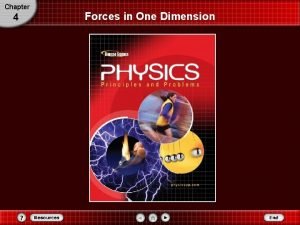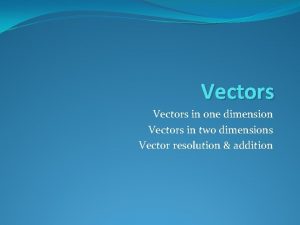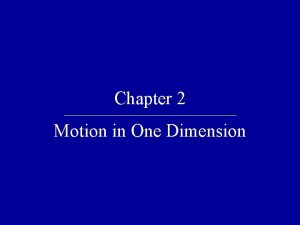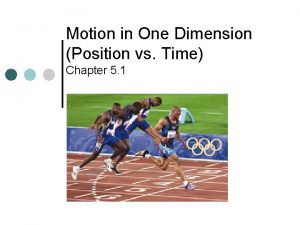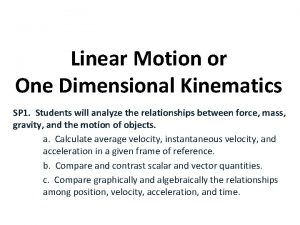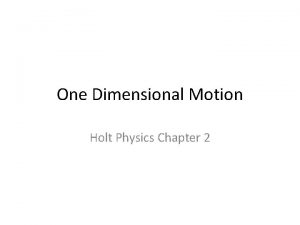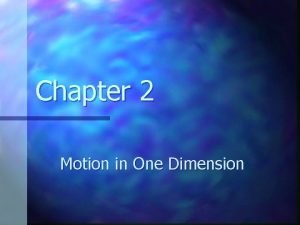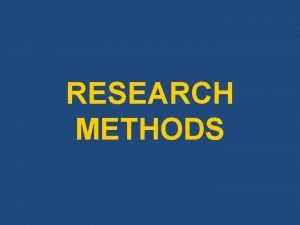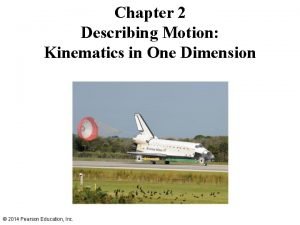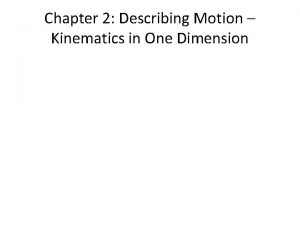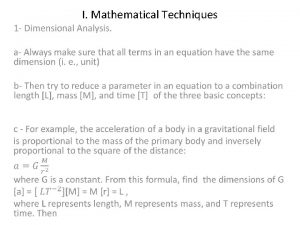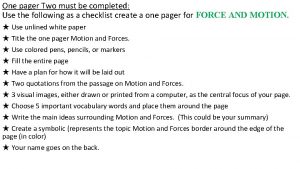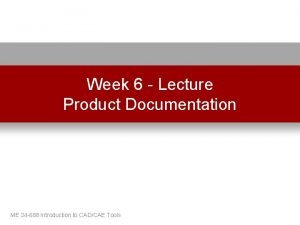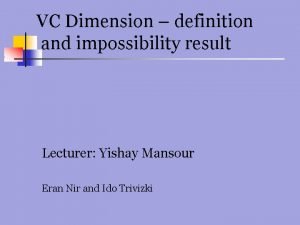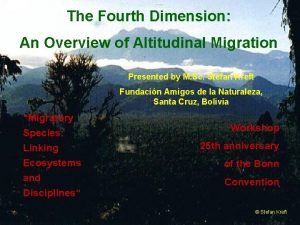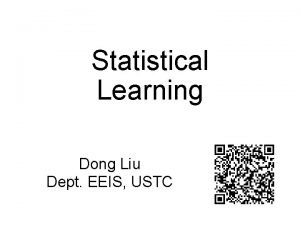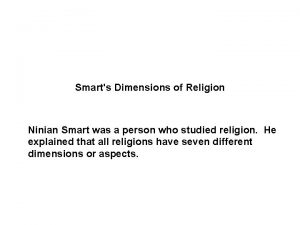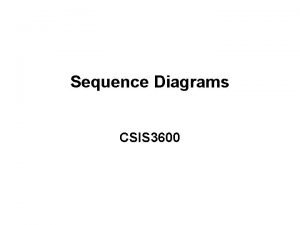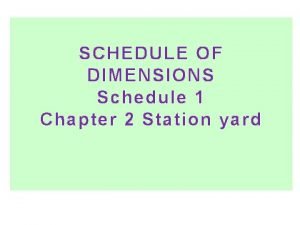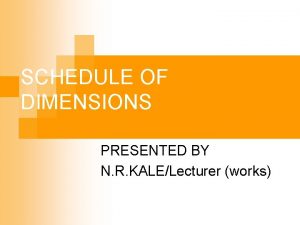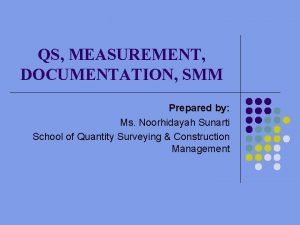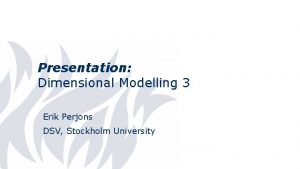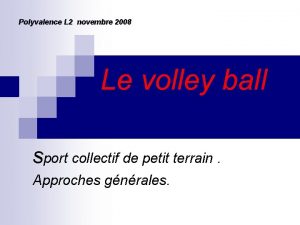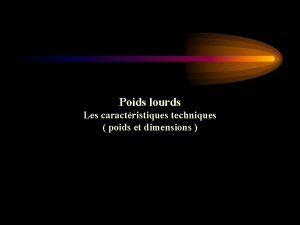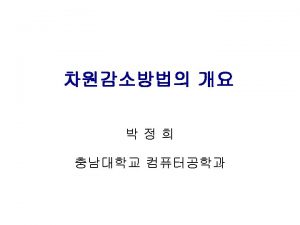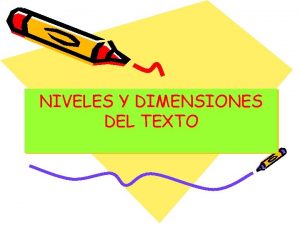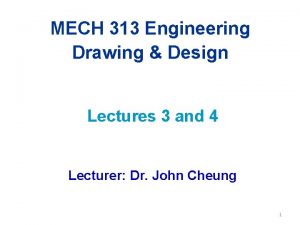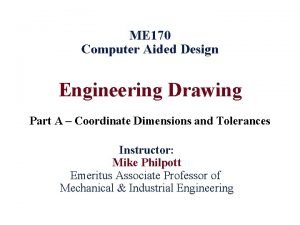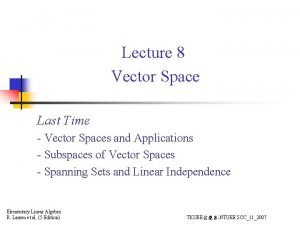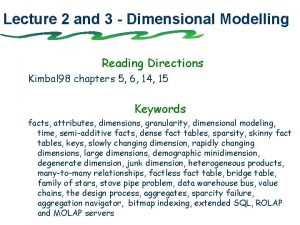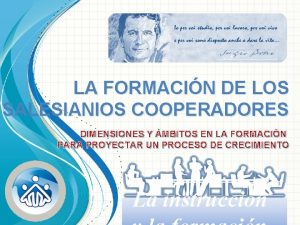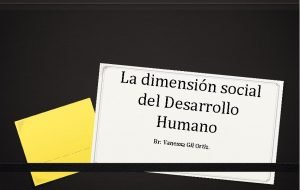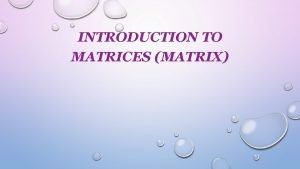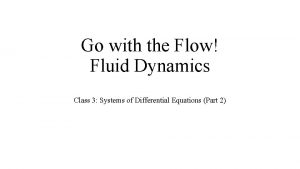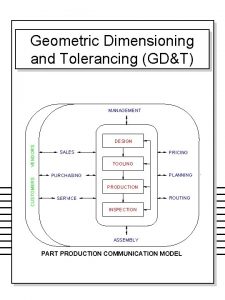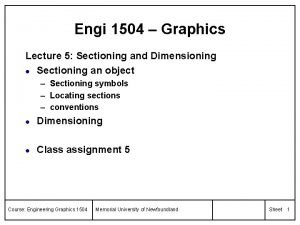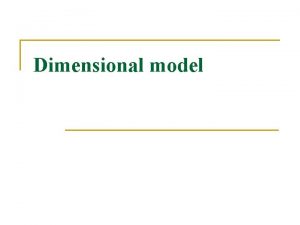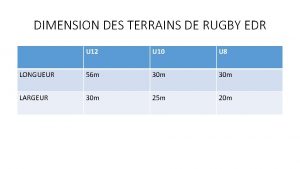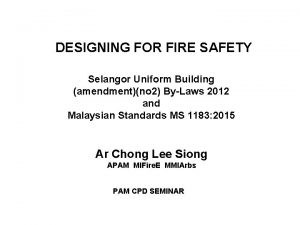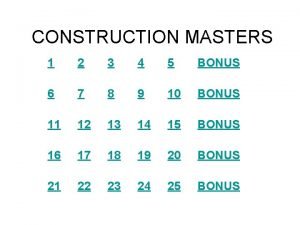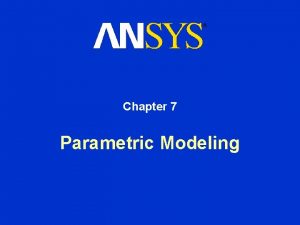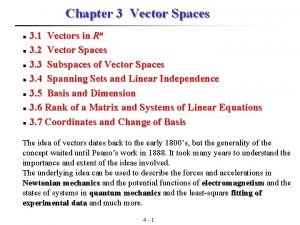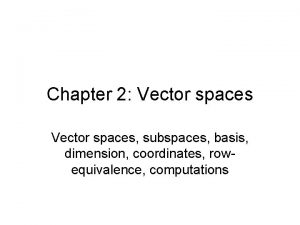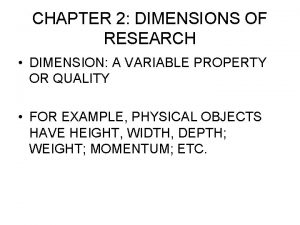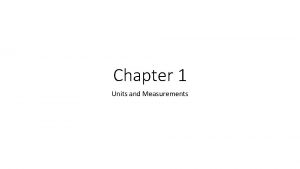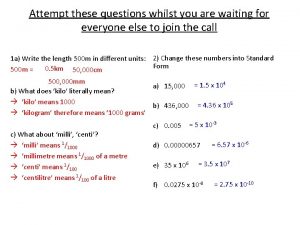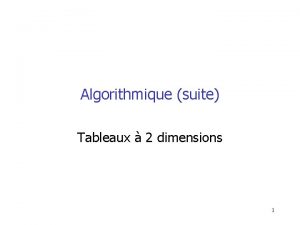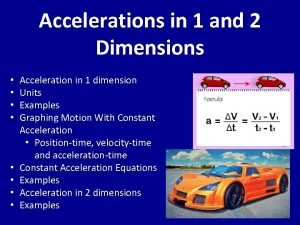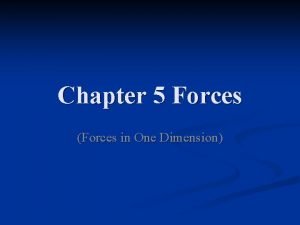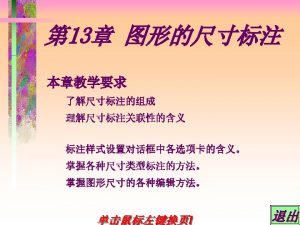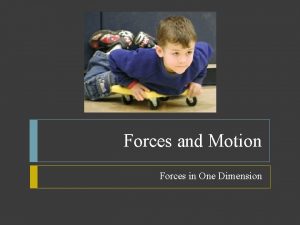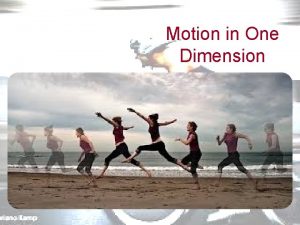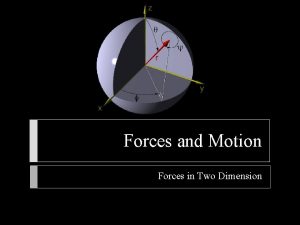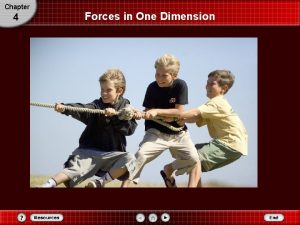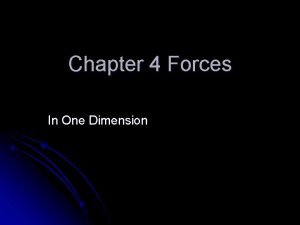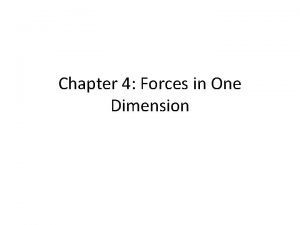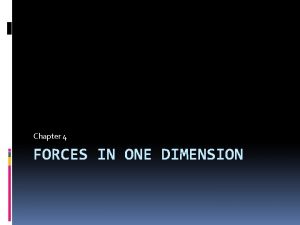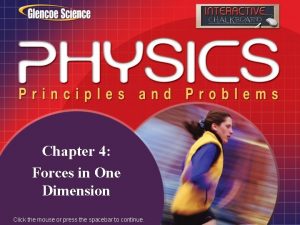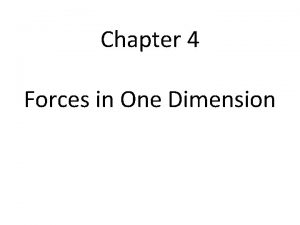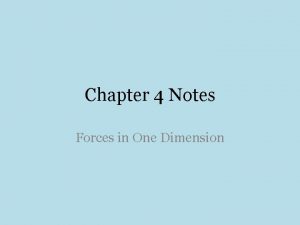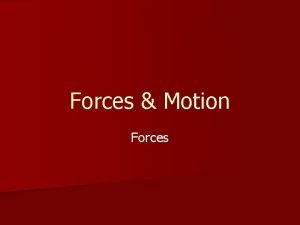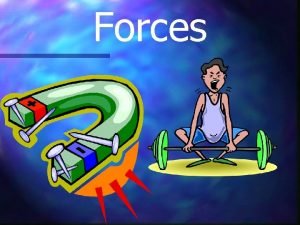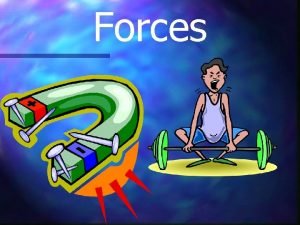Chapter 4 Forces in One Dimension Chapter 4




























































































- Slides: 92

Chapter 4 Forces in One Dimension

Chapter 4 Forces in One Dimension In this chapter you will: Use Newton’s laws to solve problems. Determine the magnitude and direction of the net force that causes a change in an object’s motion. Classify forces according to the agents that cause them. *VD Note

Chapter 4 Table of Contents Chapter 4: Forces in One Dimension Section 4. 1: Force and Motion Section 4. 2: Using Newton's Laws Section 4. 3: Interaction Forces

Section Force and Motion 4. 1 In this section you will: Define force. Apply Newton’s second law to solve problems. Explain the meaning of Newton’s first law.

Section 4. 1 Force and Motion A force is defined as a push or pull exerted on an object. Forces can cause objects to speed up, slow down, or change direction as they move. Based on the definitions of velocity and acceleration, a force exerted on an object causes that object’s velocity to change; that is, a force causes an acceleration.

Section 4. 1 Force and Motion Consider a textbook resting on a table. How can you cause it to move? Two possibilities are that you can push on it or you can pull on it. The push or pull is a force that you exert on the textbook. If you push harder on an object, you have a greater effect on its motion. The direction in which force is exerted also matters. If you push the book to the right, the book moves towards right. The symbol F is a vector and represents the size and direction of a force, while F represents only the magnitude.

Section 4. 1 Force and Motion When considering how a force affects motion, it is important to identify the object of interest. This object is called the system. Everything around the object that exerts forces on it is called the external world.

Section 4. 1 Force and Motion Contact Forces and Field Forces Think about the different ways in which you could move a textbook. You could touch it directly and push or pull it, or you could tie a string around it and pull on the string. These are examples of contact forces. A contact force exists when an object from the external world touches a system and thereby exerts a force on it.

Section 4. 1 Force and Motion Contact Forces and Field Forces If you drop a book, the gravitational force of Earth causes the book to accelerate, whether or not Earth is actually touching it. This is an example of a field force. Field forces are exerted without contact. Forces result from interactions; thus, each force has a specific and identifiable cause called the agent. Without both an agent and a system, a force does not exist. A physical model which represents the forces acting on a system, is called a free-body diagram.

Section 4. 1 Force and Motion Contact Forces and Field Forces Click image to view movie.

Section 4. 1 Force and Motion Force and Acceleration To determine how force, acceleration, and velocity are related, perform the following experiment. Begin by considering a simple situation of one controlled force exerted horizontally on an object. The horizontal direction is a good place to start because gravity does not act horizontally. Also, to reduce complications resulting from the object rubbing against the surface, do the experiments on a very smooth surface, such as ice or a very well-polished table, and use an object with wheels that spin easily.

Section 4. 1 Force and Motion Force and Acceleration You need to be able to exert a constant and controlled force on an object. A stretched rubber band exerts a pulling force; the farther you stretch it, the greater the force with which it pulls back. Stretch the rubber band for a constant distance of 1 cm to exert a constant force on the cart.

Section 4. 1 Force and Motion Force and Acceleration If you perform this experiment and determine the cart’s velocity for some period of time, you can construct a graph as shown here. The graph indicates that the constant increase in the velocity is a result of the constant acceleration the stretched rubber band gives the cart.

Section 4. 1 Force and Motion Force and Acceleration To determine how acceleration depends on force, increase the force applied on the cart gradually. To get a greater amount of force, stretch the rubber band farther. Plot a velocity-time graph for each 2 cm, 3 cm and so on and calculate the acceleration.

Section 4. 1 Force and Motion Force and Acceleration Plot the accelerations and forces for all the trials to make a force-acceleration graph. The relationship between the force and acceleration is linear, where the greater the force is, the greater the resulting acceleration.

Section 4. 1 Force and Motion Force and Acceleration To determine the physical meaning of the slope on the force-acceleration graph, increase the number of carts gradually. A plot of the force versus acceleration for one, two, and three carts indicates that if the same force is applied in each situation, the acceleration of two carts is the acceleration of one cart, and the acceleration of three carts is the acceleration of one cart.

Section 4. 1 Force and Motion Force and Acceleration This means that as the number of carts is increased, a greater force is needed to produce the same acceleration. The slopes of the lines in the graph depend upon the number of carts; that is, the slope depends on the total mass of the carts.

Section 4. 1 Force and Motion Force and Acceleration If the slope, k, is defined as the reciprocal of the mass The equation indicates that a force applied to an object causes the object to accelerate.

Section 4. 1 Force and Motion Force and Acceleration The formula, , tells you that if you double the force, you will double the object’s acceleration. If you apply the same force to several different objects, the one with the most mass will have the smallest acceleration and the one with the least mass will have the greatest acceleration. One unit of force causes a 1 -kg mass to accelerate at 1 m/s 2, so one force unit has the dimensions 1 kg·m/s 2 or one newton and is represented by N.

Section 4. 1 Force and Motion Combining Forces When the force vectors are in the same direction, they can be replaced by a vector with a length equal to their combined length. If the forces are in opposite directions, the resulting vector is the length of the difference between the two vectors, in the direction of the greater force. Vector sum of all the forces on an object is net force.

Section 4. 1 Force and Motion Newton’s Second Law The observation that acceleration of an object is proportional to the net force exerted on it and inversely proportional to its mass is the Newton’s second law, which can be represented in the following equation. Newton’s second law states that the acceleration of an object is equal to the sum of the forces acting on the object, divided by the mass of the object.

Section 4. 1 Force and Motion Newton’s Second Law Here is a useful strategy for finding how the motion of an object depends on the forces exerted on it. First, identify all the forces acting on the object. Draw a free-body diagram showing the direction and relative strength of each force acting on the system.

Section 4. 1 Force and Motion Newton’s Second Law Then, add the forces to find the net force. Next, use Newton’s second law to calculate the acceleration. Finally, if necessary, use kinematics to find the velocity or position of the object.

Section 4. 1 Force and Motion Newton’s First Law What is the motion of an object with no net force acting on it? A stationary object with no net force acting on it will stay at its position. Galileo did many experiments, and he concluded that in the ideal case of zero resistance, horizontal motion would never stop. Galileo was the first to recognize that the general principles of motion could be found by extrapolating experimental results to the ideal case, in which there is no resistance to slow down an object’s motion.

Section 4. 1 Force and Motion Newton’s First Law In the absence of a net force, the motion (or lack of motion) of both the moving object and the stationary object continues as it was. Newton recognized this and generalized Galileo’s results in a single statement. This statement, “an object that is at rest will remain at rest, and an object that is moving will continue to move in a straight line with constant speed, if and only if the net force acting on that object is zero, ” is called Newton’s first law.

Section 4. 1 Force and Motion Newton’s First Law Newton’s first law is sometimes called the law of inertia. Inertia is the tendency of an object to resist change. If an object is at rest, it tends to remain at rest. If it is moving at a constant velocity, it tends to continue moving at that velocity. Forces are results of interactions between two objects; they are not properties of single objects, so inertia cannot be a force.

Section 4. 1 Force and Motion Newton’s First Law If the net force on an object is zero, then the object is in equilibrium. An object is in equilibrium if it is at rest or if it is moving at a constant velocity. Newton’s first law identifies a net force as something that disturbs the state of equilibrium. Thus, if there is no net force acting on the object, then the object does not experience a change in speed or direction and is in equilibrium.

Section 4. 1 Force and Motion Newton’s First Law Some of the common types of forces are displayed on the right. When analyzing forces and motion, it is important to keep in mind that the world is dominated by resistance. Newton’s ideal, resistancefree world is not easy to visualize.

Section Check 4. 1 Question 1 Two horses are pulling a 100 -kg cart in the same direction, applying a force of 50 N each. What is the acceleration of the cart? A. 2 m/s 2 B. 1 m/s 2 C. 0. 5 m/s 2 D. 0 m/s 2

Section 4. 1 Section Check Answer 1 Answer: B Reason: If we consider positive direction to be the direction of pull then, according to Newton’s second law,

Section Check 4. 1 Question 2 Two friends Mary and Maria are trying to pull a 10 -kg chair in opposite directions. If Maria applied a force of 60 N and Mary applied a force of 40 N, in which direction will the chair move and with what acceleration? A. The chair will move towards Mary with an acceleration of 2 m/s 2. B. The chair will move towards Mary with an acceleration of 10 m/s 2. C. The chair will move towards Maria with an acceleration of 2 m/s 2. D. The chair will move towards Maria with an acceleration of 10 m/s 2.

Section 4. 1 Section Check Answer 2 Answer: C Reason: Since the force is applied in opposite direction, if we consider Maria’s direction of pull to be positive direction then, net force = 60 N – 40 N = 20 N. Thus, the chair will move towards Maria with an acceleration.

Section 4. 1 Section Check Question 3 State Newton’s first law.

Section 4. 1 Section Check Answer 3 Newton’s first law states that “an object that is at rest will remain at rest, and an object that is moving will continue to move in a straight line with constant speed, if and only if the net force acting on that object is zero”.

Chapter 4. 2 Using Newton's Laws In this section you will: Describe how the weight and the mass of an object are related. Differentiate between actual weight and apparent weight.

Section 4. 2 Using Newton's Laws Using Newton’s Second Law Newton’s second law tells you that the weight force, Fg, exerted on an object of mass m is. Consider a free-falling ball in midair. It is touching nothing and air resistance can be neglected, the only force acting on it is Fg.

Section 4. 2 Using Newton's Laws Using Newton’s Second Law The ball’s acceleration is g. So, Newton’s second law, then becomes Both the force and the acceleration are downward. The magnitude of an object’s weight is equal to its mass times the acceleration due to gravity.

Section 4. 2 Using Newton's Laws Using Newton’s Second Law How does a bathroom scale work? When you stand on the scale, the spring in the scale exerts an upward force on you because you are in contact with it. Because you are not accelerating, the net force acting on you must be zero. The spring force, Fsp, upwards must be the same magnitude as your weight, Fg, downwards.

Section 4. 2 Using Newton's Laws Fighting Over a Toy Anudja is holding a stuffed dog, with a mass of 0. 30 kg, when Sarah decides that she wants it and tries to pull it away from Anudja. If Sarah pulls horizontally on the dog with a force of 10. 0 N and Anudja pulls with a horizontal force of 11. 0 N, what is the horizontal acceleration of the dog?

Section 4. 2 Using Newton's Laws Fighting Over a Toy Step 1: Analyze and Sketch the Problem

Section 4. 2 Using Newton's Laws Fighting Over a Toy Sketch the situation and identify the dog as the system and the direction in which Anudja pulls as positive.

Section 4. 2 Using Newton's Laws Fighting Over a Toy Identify known and unknown variables. Known: Unknown: m = 0. 30 kg a=? FAnudja on dog = 11. 0 N FSarah on dog = 10. 0 N

Section 4. 2 Using Newton's Laws Fighting Over a Toy Step 2: Solve for the Unknown

Section 4. 2 Using Newton's Laws Fighting Over a Toy Use Newton’s second law to solve for a.

Section 4. 2 Using Newton's Laws Fighting Over a Toy Substitute Fnet= FAnudja on dog+ (–FSarah on dog)

Section 4. 2 Using Newton's Laws Fighting Over a Toy Substitute FAnudja on dog = 11. 0 N, FSarah on dog = 10. 0 N, m = 0. 30 kg

Section 4. 2 Using Newton's Laws Fighting Over a Toy Step 3: Evaluate the Answer

Section 4. 2 Using Newton's Laws Fighting Over a Toy Are the units correct? m/s 2 is the correct unit for acceleration. Does the sign make sense? The acceleration is in the positive direction because Anudja is pulling in the positive direction with a greater force than Sarah is pulling in the negative direction. Is the magnitude realistic? It is a reasonable acceleration for a light, stuffed toy.

Section 4. 2 Using Newton's Laws Fighting Over a Toy The steps covered were: Step 1: Analyze and Sketch the Problem – Sketch the situation. – Identify the dog as the system and the direction in which Anudja pulls as positive. – Draw the free-body diagram. Label the forces. Step 2: Solve for the Unknown Step 3: Evaluate the Answer

Section 4. 2 Using Newton's Laws Apparent Weight Click image to view movie.

Section 4. 2 Using Newton's Laws Drag Force and Terminal Velocity When an object moves through any fluid, such as air or water, the fluid exerts a drag force on the moving object in the direction opposite to its motion. A drag force is the force exerted by a fluid on the object moving through the fluid. This force is dependent on the motion of the object, the properties of the object, and the properties of the fluid (viscosity and temperature) that the object is moving through. As the ball’s velocity increases, so does the drag force. The constant velocity that is reached when the drag force equals the force of gravity is called the terminal velocity.

Section 4. 2 Using Newton's Laws Drag Force and Terminal Velocity Click image to view movie.

Section Check 4. 2 Question 1 If mass of a person on Earth is 20 kg, what will be his mass on moon? (Gravity on Moon is six times less than the gravity on Earth. ) A. B. C. D.

Section 4. 2 Section Check Answer 1 Answer: C Reason: Mass of an object does not change with the change in gravity, only the weight changes.

Section Check 4. 2 Question 2 Your mass is 100 kg, and you are standing on a bathroom scale in an elevator. What is the scale reading when the elevator is falling freely? A. B. C. D.

Section 4. 2 Section Check Answer 2 Answer: B Reason: Since the elevator is falling freely with acceleration g, the contact force between elevator and you is zero. As scale reading displays the contact force, it would be zero.

Section Check 4. 2 Question 3 In which of the following cases will your apparent weight be greater than your real weight? A. The elevator is at rest. B. The elevator is accelerating in upward direction. C. The elevator is accelerating in downward direction. D. Apparent weight is never greater than real weight.

Section 4. 2 Section Check Answer 3 Answer: B Reason: When the elevator is moving upwards, your apparent weight (where m is your mass and a is the acceleration of the elevator). So your apparent becomes more than your real weight.

Chapter 4. 3 Interaction Forces In this section you will: Define Newton’s third law. Explain the tension in ropes and strings in terms of Newton’s third law. Define the normal force. Determine the value of the normal force by applying Newton’s second law.

Section 4. 3 Interaction Forces Identifying Interaction Forces When you exert a force on your friend to push him forward, he exerts an equal and opposite force on you, which causes you to move backwards. The forces FA on B and FB on A are an interaction pair. An interaction pair is two forces that are in opposite directions and have equal magnitude.

Section 4. 3 Interaction Forces Identifying Interaction Forces An interaction pair is also called an action-reaction pair of forces. This might suggest that one causes the other; however, this is not true. For example, the force of you pushing your friend doesn’t cause your friend to exert a force on you. The two forces either exist together or not at all. They both result from the contact between the two of you.

Section Interaction Forces 4. 3 Newton’s Third Law The force of you on your friend is equal in magnitude and opposite in direction to the force of your friend on you. This is summarized in Newton’s third law, which states that all forces come in pairs. Newton’s Third Law states that the force of A on B is equal in magnitude and opposite in direction of the force of B on A. The two forces in a pair act on different objects and are equal and opposite. Numerically,

Section 4. 3 Interaction Forces Drag Force and Terminal Velocity

Section 4. 3 Interaction Forces Earth’s Acceleration When a softball with a mass of 0. 18 kg is dropped, its acceleration toward Earth is equal to g, the acceleration due to gravity. What is the force on Earth due to the ball, and what is Earth’s resulting acceleration? Earth’s mass is 6. 0× 1024 kg.

Section 4. 3 Interaction Forces Earth’s Acceleration Step 1: Analyze and Sketch the Problem

Section 4. 3 Interaction Forces Earth’s Acceleration Draw free-body diagrams for the two systems: the ball and Earth and connect the interaction pair by a dashed line.

Section 4. 3 Interaction Forces Earth’s Acceleration Identify known and unknown variables. Known: Unknown: mball = 0. 18 kg FEarth on ball = ? m. Earth = 6. 0× 1024 kg a. Earth = ? g = 9. 80 m/s 2

Section 4. 3 Interaction Forces Earth’s Acceleration Step 2: Solve for the Unknown

Section 4. 3 Interaction Forces Earth’s Acceleration Use Newton’s second and third laws to find a. Earth.

Section 4. 3 Interaction Forces Earth’s Acceleration Substitute a = –g

Section 4. 3 Interaction Forces Earth’s Acceleration Substitute mball = 0. 18 kg, g = 9. 80 m/s 2

Section 4. 3 Interaction Forces Earth’s Acceleration Use Newton’s second and third laws to solve for FEarth on ball and a. Earth.

Section 4. 3 Interaction Forces Earth’s Acceleration Substitute FEarth on ball = – 1. 8 N

Section 4. 3 Interaction Forces Earth’s Acceleration Use Newton’s second and third laws to find a. Earth.

Section 4. 3 Interaction Forces Earth’s Acceleration Substitute Fnet = 1. 8 N, m. Earth= 6. 0× 1024 kg

Section 4. 3 Interaction Forces Earth’s Acceleration Are the units correct? Dimensional analysis verifies force in N and acceleration in m/s 2. Does the sign make sense? Force and acceleration should be positive. Is the magnitude realistic? Because of Earth’s large mass, the acceleration should be small.

Section 4. 3 Interaction Forces Earth’s Acceleration The steps covered were: Step 1: Analyze and Sketch the Problem – Draw free-body diagrams for the two systems: the ball and Earth. – Connect the interaction pair by a dashed line. Step 2: Solve for the Unknown Step 3: Evaluate the Answer

Section 4. 3 Interaction Forces of Ropes and Strings The force exerted by a string or rope is called tension. At any point in a rope, the tension forces are pulling equally in both directions.

Section 4. 3 Interaction Forces of Ropes and Strings

Section 4. 3 Interaction Forces The Normal Force The normal force is the perpendicular contact force exerted by a surface on another object. The normal force is important when calculating resistance.

Section 4. 3 Section Check Question 1 Explain Newton’s third law.

Section 4. 3 Section Check Answer 1 Suppose you push your friend, the force of you on your friend is equal in magnitude and opposite in direction to the force of your friend on you. This is summarized in Newton’s third law, which states that forces come in pair. The two forces in a pair act on different objects and are equal in strength and opposite in direction. Newton’s third law The force of A on B is equal in magnitude and opposite in direction of the force of B on A.

Section Check 4. 3 Question 2 If a stone is hung from a rope with no mass, at which place on the rope will there be more tension? A. The top of the rope, near the hook. B. The bottom of the rope, near the stone. C. The middle of the rope. D. The tension will be same throughout the rope.

Section 4. 3 Section Check Answer 2 Answer: D Reason: Because the rope is assumed to be without mass, the tension everywhere in the rope is equal to the stone’s weight.

Section 4. 3 Section Check Question 3 In a tug-of-war event, both teams A and B exert an equal tension of 200 N on the rope. What is the tension in the rope? In which direction will the rope move? Explain with the help of Newton’s third law.

Section 4. 3 Section Check Answer 3 Team A exerts a tension of 200 N on the rope. Thus, FA on rope = 200 N. Similarly, FB on rope = 200 N. But the two tensions are an interaction pair, so they are equal and opposite. Thus, the tension in the rope equals the force with which each team pulls (i. e. 200 N). According to Newton’s third law, FA on rope = FB on rope. The net force is zero, so the rope will stay at rest as long as the net force is zero.

Chapter 4 Forces in One Dimension End of Chapter

Section 4. 1 Force and Motion Combining Forces If you and your friend exert a force of 100 N each on a table, first in the same direction and then in the opposite directions, what is the net force? In the first case, your friend is pushing with a negative force of 100 N. Adding them together gives a total force of 0 N. In the second case, your friend’s force is 100 N, so the total force is 200 N in the positive direction and the table accelerates in the positive direction. Click the Back button to return to original slide.

Section 4. 1 Force and Motion Newton’s Second Law Newton’s second law can be rearranged to the form F = ma, which you learned about previously. Assume that the table that you and your friend were pushing was 15. 0 kg and the two of you each pushed with a force of 50. 0 N in the same direction. To find out what the acceleration of the table would be, calculate the net force, 50. 0 N + 50. 0 N = 100. 0 N, and apply Newton’s second law by dividing the net force of 100. 0 N by the mass of the table, 15. 0 kg, to get an acceleration of 6. 67 m/s 2. Click the Back button to return to original slide.

Section 4. 3 Interaction Forces of Ropes and Strings Tension forces are at work in a tug-of-war. If team A, on the left, is exerting a force of 500 N and the rope does not move, then team B, must also be pulling with 500 N. Click the Back button to return to original slide.

Section 4. 2 Using Newton's Laws Fighting Over a Toy Anudja is holding a stuffed dog, with a mass of 0. 30 kg, when Sarah decides that she wants it and tries to pull it away from Anudja. If Sarah pulls horizontally on the dog with a force of 10. 0 N and Anudja pulls with a horizontal force of 11. 0 N, what is the horizontal acceleration of the dog? Click the Back button to return to original slide.

Section 4. 3 Interaction Forces Earth’s Acceleration When a softball with a mass of 0. 18 kg is dropped, its acceleration toward Earth is equal to g, the acceleration due to gravity. What is the force on Earth due to the ball, and what is Earth’s resulting acceleration? Earth’s mass is 6. 0× 1024 kg. Click the Back button to return to original slide.
 Forces in one dimension
Forces in one dimension 4-1 forces and acceleration
4-1 forces and acceleration Vf-vo
Vf-vo Parallel force system
Parallel force system The forces shown above are pushing/pulling forces
The forces shown above are pushing/pulling forces Intermolecular vs intramolecular
Intermolecular vs intramolecular Intermolecular forces ranked
Intermolecular forces ranked Intramolecular forces vs intermolecular forces
Intramolecular forces vs intermolecular forces Contact forces
Contact forces Balanced forces and unbalanced forces venn diagram
Balanced forces and unbalanced forces venn diagram Is erosion constructive or destructive
Is erosion constructive or destructive Vectors in two dimension
Vectors in two dimension Motion in one dimension quiz
Motion in one dimension quiz To describe a position in more than one dimension
To describe a position in more than one dimension What is negative velocity on a graph
What is negative velocity on a graph Holt physics motion in one dimension answers
Holt physics motion in one dimension answers Free fall motion in one dimension
Free fall motion in one dimension Undefined terms and basic definitions worksheet answers
Undefined terms and basic definitions worksheet answers Example of time dimension in research
Example of time dimension in research Motion in one dimension
Motion in one dimension Describing motion kinematics in one dimension
Describing motion kinematics in one dimension Describing motion kinematics in one dimension
Describing motion kinematics in one dimension Motion in one dimension
Motion in one dimension Mathematical techniques
Mathematical techniques One god one empire one religion
One god one empire one religion One one one little puppy run
One one one little puppy run One king one law one faith
One king one law one faith One empire one god one emperor
One empire one god one emperor Ford one plan
Ford one plan See one do one teach one
See one do one teach one One price policy
One price policy Structure of twelfth night
Structure of twelfth night Studiendekanat uni bonn
Studiendekanat uni bonn Asean tourism strategic plan
Asean tourism strategic plan Graphic organizer with the aims of la liga filipina
Graphic organizer with the aims of la liga filipina Types of simple machines
Types of simple machines Decimal tolerance chart
Decimal tolerance chart Vc bound
Vc bound Vc dimension explained
Vc dimension explained Dimension psicologica de la sexualidad humana
Dimension psicologica de la sexualidad humana Fourth dimension immigration
Fourth dimension immigration Storage cell dimension
Storage cell dimension Vc dimension
Vc dimension Ninian smarts 7 dimensions
Ninian smarts 7 dimensions The vertical dimension of sequence diagram shows
The vertical dimension of sequence diagram shows Schedule of dimensions
Schedule of dimensions A class odc gross clearance
A class odc gross clearance Relational dimension of communication
Relational dimension of communication Dotting on in quantity surveying
Dotting on in quantity surveying Dimension convivencial
Dimension convivencial Ejemplos de dimensión comunitaria en la escuela
Ejemplos de dimensión comunitaria en la escuela Degenerate dimension
Degenerate dimension Terrain volleyball dimension
Terrain volleyball dimension Poids lourd dimension
Poids lourd dimension Vc dimension rectangle
Vc dimension rectangle Réduction de dimension
Réduction de dimension Dimensiones del texto narrativo
Dimensiones del texto narrativo Visión personal proyecto de vida
Visión personal proyecto de vida Recess in engineering drawing
Recess in engineering drawing Reference dimension
Reference dimension Dimension of a vector space
Dimension of a vector space Degenerate dimension
Degenerate dimension Dimension humana
Dimension humana Dimension socioemocional
Dimension socioemocional Dimension comunicativa
Dimension comunicativa Matrix dimension
Matrix dimension Characteristic linear dimension reynolds number
Characteristic linear dimension reynolds number Basic dimension
Basic dimension Howard gardner hendricks
Howard gardner hendricks Reference dimension example
Reference dimension example Dimensiones de la practica docente
Dimensiones de la practica docente Hyperion essbase tutorial
Hyperion essbase tutorial Degenerate dimension
Degenerate dimension Dimension stade de rugby
Dimension stade de rugby Dimension data learning
Dimension data learning Notacional significado
Notacional significado Dimensioning in technical drawing
Dimensioning in technical drawing Ms 1183:2015 download
Ms 1183:2015 download A grid divides an area into small parts called
A grid divides an area into small parts called Classroom dimensions
Classroom dimensions Reference dimension example
Reference dimension example Dimension of a vector
Dimension of a vector Dimension of a vector space
Dimension of a vector space Dimensions of research
Dimensions of research Dimension of service quality
Dimension of service quality Basic si units table
Basic si units table Dimension de la estrategia general
Dimension de la estrategia general Chamfer dimension callout
Chamfer dimension callout F=6πηrv derivation
F=6πηrv derivation Pengertian array 1 dimensi dan 2 dimensi
Pengertian array 1 dimensi dan 2 dimensi Dimensión trascendental
Dimensión trascendental Algorithme tableau 2 dimensions
Algorithme tableau 2 dimensions Acceleration in two dimensions
Acceleration in two dimensions

